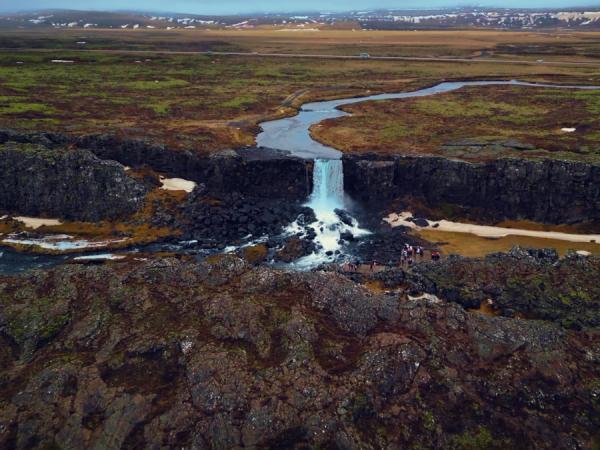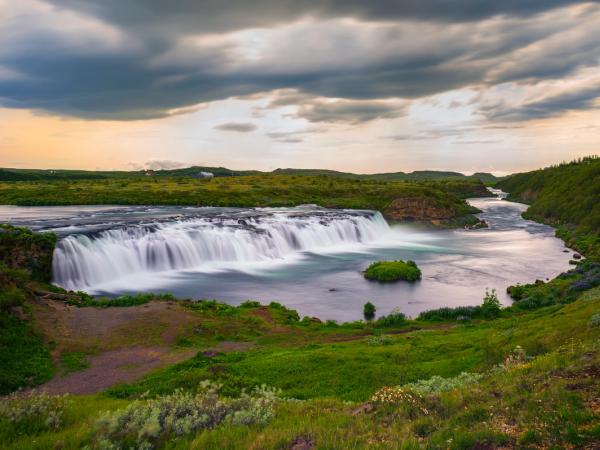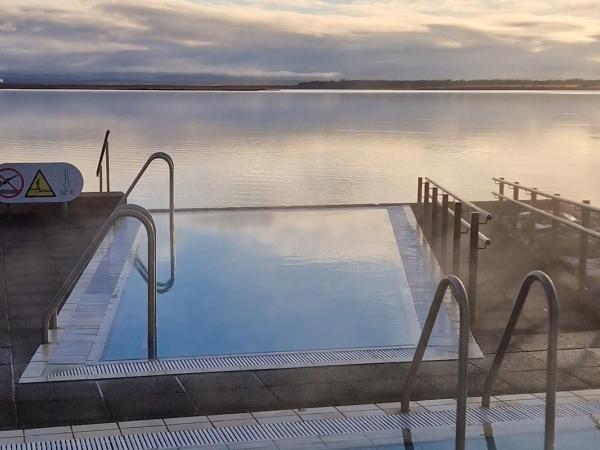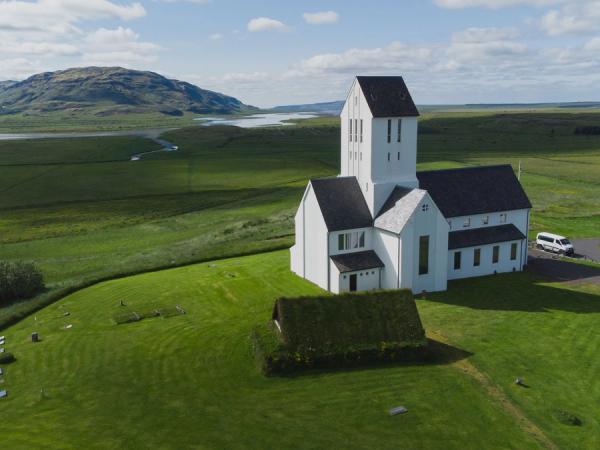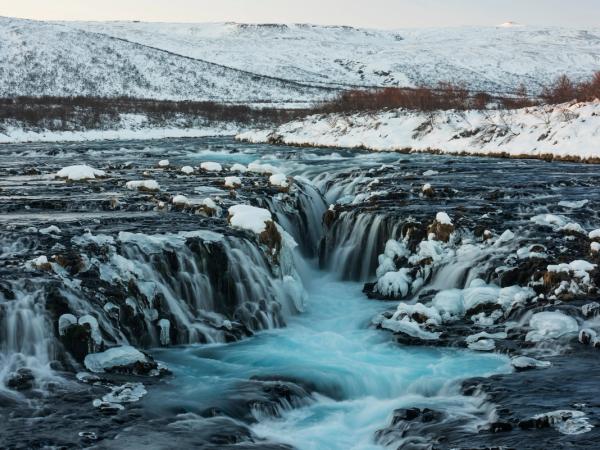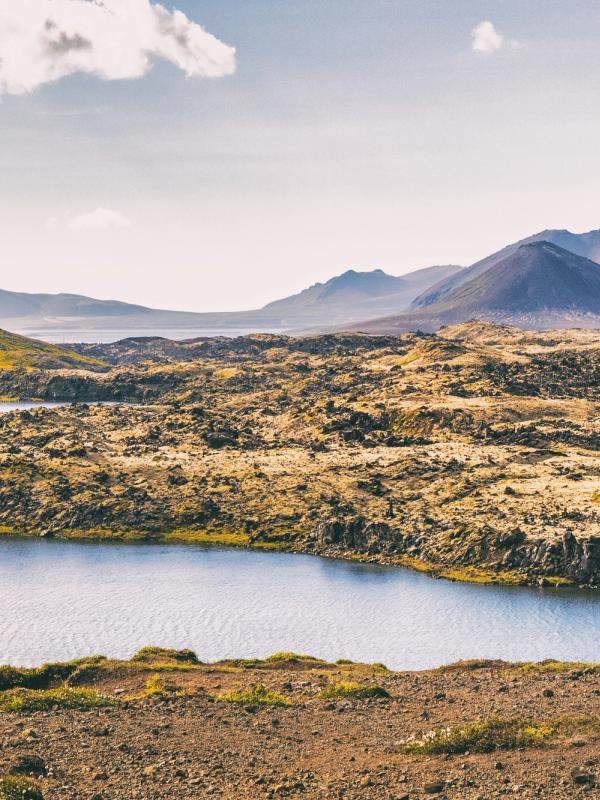
Iceland's Golden Circle: Nature, History, & Hot Springs
The Golden Circle in Iceland encompasses some of Iceland's most striking natural features within a fairly small area. In a single day trip, you can see geysers shooting up, stand between continental plates, and watch powerful waterfalls - all within an easy drive from Reykjavík.
This guide covers what you need to know about visiting the Golden Circle, from the main stops to helpful travel tips.
Key takeaways
- The Golden Circle is a 300 km (190-mile) circular route from Reykjavík with three main stops: Þingvellir National Park, Geysir Geothermal Area, and Gullfoss Waterfall.
- You can complete it in one day (6-8 hours), but adding stops like Kerið Crater or Secret Lagoon makes for a fuller experience
- You can drive yourself (for flexibility) or take a guided tour (for information and no driving).
- The route is open year-round, though winter requires planning for road conditions and shorter days.
- Bring layers and waterproof clothes, no matter when you visit - Icelandic weather changes fast.
Overview of the Golden Circle
The Golden Circle is Iceland's most visited sightseeing route. This 300-kilometer loop starts and ends in Reykjavík, taking you to some of the country's most impressive natural sites in a compact, easy-to-navigate journey.
The name comes from the circular route and one of its main attractions, Gullfoss, which translates to "Golden Falls" in Icelandic. The route was created to showcase Iceland's unique landscapes, history, and natural features in a single day trip.
What makes this route stand out is how it fits so much variety into one journey. Within a few hours, you see the meeting point of tectonic plates, watch geysers shoot water into the air, and stand beside a massive waterfall. It's basically a sampler platter of what makes Iceland interesting.
The entire route follows well-kept roads, making it suitable for normal cars in summer and accessible with the right vehicle and planning in winter.
How Much Time Does it Take to Complete the Golden Circle?
The driving time for the Golden Circle is approximately 3-4 hours, excluding stops. But the stops are the whole point. With time at each main attraction, a typical Golden Circle trip takes 8-10 hours.
Most people make it a full-day trip, leaving Reykjavík in the morning and returning in the evening. This gives you enough time at each site without feeling rushed.
If you prefer a slower pace or want to add extra stops, you might want to spread your Golden Circle trip across two or even three days. This allows you more time at each place, room for detours to less-visited spots, and flexibility to enjoy activities like soaking in hot springs.
For photography, the extra time can be particularly useful, allowing you to see sites in different lighting conditions or wait for a moment when there are fewer people around.
Golden Circle Main Stops
The Golden Circle centers on three main natural attractions that show off Iceland's diverse landscapes. Each stop offers you something completely different, creating a good introduction to Iceland's geological features. These three main attractions are part of the reason why the Golden Circle is Iceland's most popular day trip.
Þingvellir National Park (Thingvellir)
Þingvellir National Park is typically the first stop if you're coming from Reykjavík, and one of the most-visited attractions in the entire country. Located about 45 kilometers northeast of the capital, this UNESCO World Heritage site has significant historical and geological importance.
This place is where the North American and Eurasian tectonic plates are visibly pulling apart, creating a rift valley. When you walk through the Almannagjá gorge, you're actually moving between continents. The plates continue to drift apart at about 2 centimeters per year, causing occasional earthquakes and slowly changing the landscape.
Beyond its geology, Þingvellir has a special place in Icelandic history. In 930 AD, Viking settlers established the Alþingi here, one of the world's first democratic parliaments. For centuries, leaders and their followers gathered yearly at Þingvellir to make laws and settle disputes. You can visit the Lögberg (Law Rock), where speakers used to address the assembly.
While exploring the park, you should visit Öxarárfoss, a waterfall that flows into the Almannagjá gorge. The clear waters of Lake Þingvallavatn, Iceland's largest natural lake, create a beautiful backdrop.
For those seeking adventure, you can snorkel or dive in the Silfra fissure, a water-filled crack between the continental plates. The water visibility reaches up to 100 meters, and the experience of floating between two continents is unique. The water temperature remains at 2-4°C year-round, so be prepared for the cold.
Walking around the park is easier than you’d expect, as it has well-maintained paths and boardwalks. The visitor center at Hakið features exhibits on the area's history and geology, as well as restrooms and a café.
Entrance to the park is free, but if you go with your own vehicle, you’ll have to pay 1,000 ISK for parking.
Geysir Geothermal Area
The second main stop is the Geysir Geothermal Area in Haukadalur Valley, about 50 kilometers from Þingvellir. This landscape of bubbling mud pools, steam vents, and erupting hot springs shows you the power of what's happening beneath Iceland's surface.
The main attraction here is Strokkur, an active geyser that erupts every 5-10 minutes, shooting water 20-30 meters into the air. You can watch the surface bubble and swell right before each eruption. If you're quick with a camera, try to catch the blue bubble that forms for a split second just before the geyser erupts.
Nearby stands the Great Geysir, which gave all geysers their name (the Icelandic word "geysa" means "to gush"). While the original Geysir is now mostly dormant, erupting only occasionally after earthquakes, it has a fascinating history. When active, it could shoot water up to 170 meters high. The area has been a known attraction since the 18th century.
As you walk around the geothermal field, you'll notice colorful mineral deposits – yellows, oranges, and reds – created by elements like sulfur and iron. The entire area smells of sulfur (like rotten eggs), which is not very pleasant, but it’s definitely a quirky experience.
The Geysir area features marked paths, and it is essential to stay on them for your safety. The ground around hot springs can be thin and unstable, and the water is hot enough to cause severe burns. The main path takes you past all the major features and typically requires about 30-60 minutes to explore.
Across the road, the Geysir Center complex has restaurants, a gift shop, and facilities. It's a great spot to grab lunch or warm up with a hot drink after exploring the geothermal area.
Same as Þingvellir, parking fee is 1000 ISK.
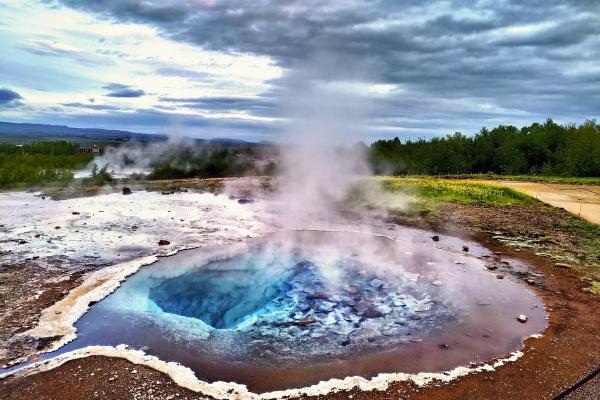
Gullfoss Waterfall
The third major stop is Gullfoss (Golden Falls), one of Iceland's most impressive waterfalls. Located just 10 kilometers from the Geysir area, Gullfoss is a powerful two-tier waterfall on the Hvítá River.
The waterfall drops a total of 32 meters (105 feet) into a narrow canyon. The upper tier falls 11 meters, and after a turn, the lower tier plunges 21 meters deeper. The amount of water is impressive, with an average flow of about 140 cubic meters per second during summer. On sunny days, the spray creates rainbows above the falls, possibly contributing to the "golden" name (though some say it refers to the golden-colored sediment in the glacial water).
As you walk from the parking area, you first hear the thundering sound before the canyon opens up, revealing the waterfall.
There are several viewing platforms for you to see Gullfoss from different angles. The upper path gives you a view from above, while the lower path (open in summer) brings you closer to the edge of the falls, where you can feel the mist. In winter, ice forms around parts of the falls, creating a frozen landscape.
Gullfoss has an interesting conservation story. In the early 20th century, foreign investors wanted to dam the Hvítá River for hydroelectric power. Sigríður Tómasdóttir, the daughter of the landowner, fought to prevent this development, even threatening to throw herself into the waterfall if construction began. Thanks to her efforts, Gullfoss was saved and became a protected reserve in 1979. You’ll see a memorial to Sigríður near the falls.
The Gullfoss area includes a visitor center with a café, gift shop, and facilities. The café serves traditional Icelandic lamb soup (kjötsúpa), good for warming you up, especially on cold days when the wind blows through the canyon.
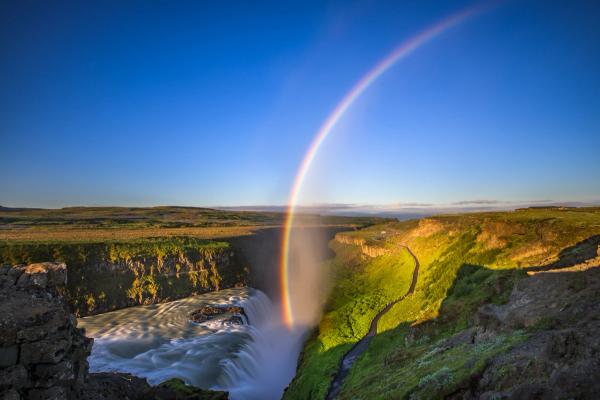
Golden Circle Hidden Gems
While these three main sites form the core of the Golden Circle, several lesser-known attractions along the route are worth visiting. These hidden gems can turn a good day trip into something even more memorable for you.
Kerið Crater
About 15 kilometers south of Selfoss, you'll find Kerið, a volcanic crater lake formed about 6,500 years ago. The crater's walls feature red volcanic rock, creating a mesmerizing contrast with the blue-green water at its center.
Kerið is relatively young compared to other volcanic features in the region. Scientists think it formed when a cone volcano depleted its magma chamber and collapsed, rather than from an explosion. The crater is about 55 meters deep and 270 meters wide.
You can walk the entire rim of the crater in about 15 minutes, seeing it from different angles. There's also a path down to the water's edge, where you can see the scale of the crater walls rising around you. The loop trail is about 550 meters long.
Unlike the main Golden Circle attractions, Kerið has a small entrance fee (approximately 600 ISK or $4) because it is located on private land. You can visit the site year-round, though you should be cautious if you visit during winter, as the path around the rim can get icy.
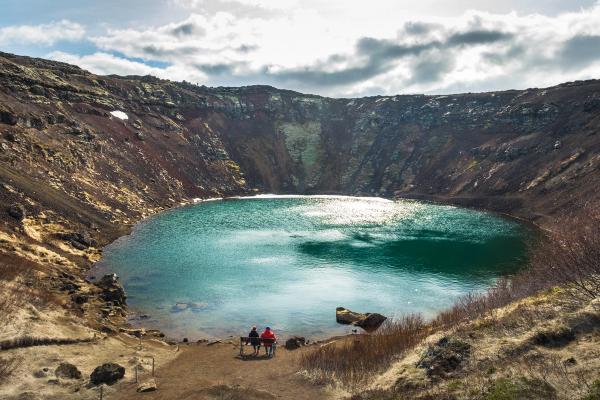
Secret Lagoon (Gamla Laugin)
For a relaxing soak in mineral-rich waters, visit the Secret Lagoon (Gamla Laugin) in the village of Flúðir, about 30 minutes from Gullfoss.
Established in 1891, the Secret Lagoon is Iceland's oldest swimming pool. Unlike the Blue Lagoon, which is way more commercial, the Secret Lagoon has a natural, simple atmosphere. The large pool is fed by nearby hot springs that keep the water at a comfortable 38-40°C year-round.
While soaking, you can watch a small geyser erupt every few minutes at the edge of the pool. The setting is particularly nice in winter when steam rises from the warm water into the cold air.
The facility has modern changing rooms, showers, and a small café. Towel and swimsuit rentals are available if you need them. You should book ahead, particularly during busy times, as the lagoon can get crowded with tour groups.
A visit to the Secret Lagoon typically takes 1-2 hours, making it a good addition to your Golden Circle day if you have the time. It's also a nice place to relax your tired muscles after a day of walking around.
The entrance ticket for the Secret Lagoon costs around 30$.
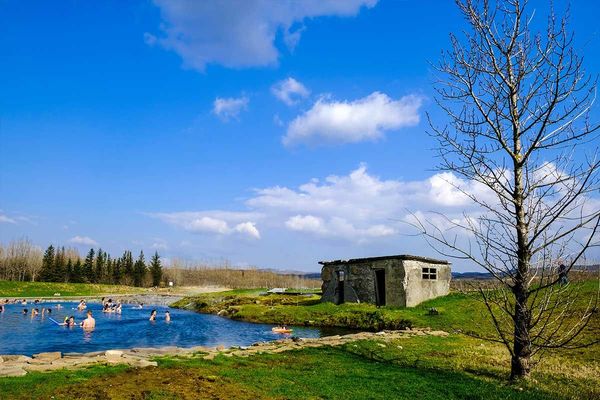
Friðheimar Greenhouse
For an unusual eating experience, visit Friðheimar, a working tomato farm and restaurant located near Reykholt. Using geothermal heat and modern farming techniques, they grow tomatoes year-round despite Iceland's cold climate.
The restaurant is inside a greenhouse, where you eat among rows of tomato plants. Their menu focuses on tomatoes, from tomato soup with fresh-baked bread to more quirky items such as tomato ice cream. You can even try tomato beer or a "Healthy Mary" cocktail.
Beyond the food, Friðheimar is excellent to learn about sustainable agriculture. Tours explain how they utilize geothermal energy for heating, employ natural predators instead of pesticides, and import bumblebees for pollination. The family that runs Friðheimar also raises Icelandic horses and occasionally hosts small horse shows in the summer.
This is a popular stop, so reservations are essential if you plan to eat here. Opening hours are typically from noon to 4 PM.
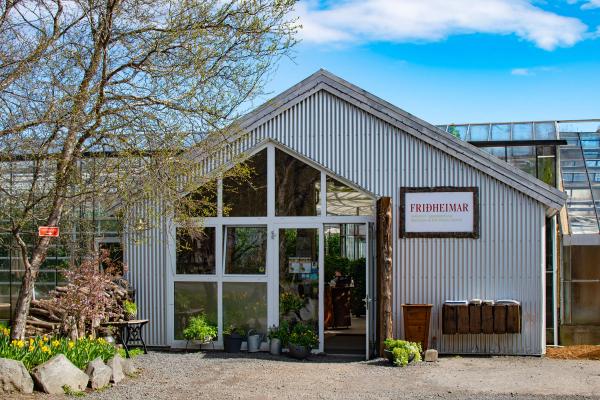
Other Worthy Stops
If you have extra time, consider these additional places:
- Brúarfoss Waterfall: Known as "Iceland's bluest waterfall," Brúarfoss requires a 3-4 km round-trip walk but rewards you with turquoise waters flowing through a narrow gorge.
- Faxi Waterfall: A smaller but pretty waterfall with a salmon ladder, Faxi makes for a peaceful stop with fewer people than Gullfoss.
- Sólheimar Eco-village: Founded in 1930, this sustainable community showcases eco-friendly living with organic farms, workshops, and a café.
- Laugarvatn Fontana: This geothermal spa offers multiple hot pools of varying temperatures, steam rooms, and a lake for cooling off. They also demonstrate traditional geothermal rye bread baking, where the dough is buried in the hot ground for 24 hours.
- Skálholt Cathedral: A historically significant religious site, Skálholt was one of Iceland's most important cultural and religious centers for centuries.
Moving Around the Golden Circle
Navigating the Golden Circle is straightforward, with several transportation options available to suit different travel preferences. Your choice may depend on factors such as how comfortable you feel driving, whether you prefer flexibility or structure, and your budget.
Self-drive
Driving yourself around the Golden Circle gives you complete flexibility, and for me, it’s the best choice. You can spend more time at places that interest you, take detours to less-visited spots, and move at your own pace. The route follows well-marked, paved roads (mainly Routes 36, 37, and 35), so it’s really easy to navigate.
In the summer, a standard 2WD car is enough for driving the Golden Circle. The main roads are well-kept and don't need special vehicles. In winter, though, you should consider renting a 4x4 vehicle with winter tires for safety in case the roads get icy or snowy.
Before starting your trip, consider downloading offline maps or bringing a paper map as a backup, although cell coverage is generally good throughout the route. The Vegagerðin app or road.is website provides current information on road conditions, which is essential if you’re driving in winter.
Gas stations are available in Selfoss, Laugarvatn, and at the Geysir complex, so keeping your tank filled isn't a problem. Remember that in Iceland, you must keep your headlights on at all times, even during daylight.
One benefit of self-driving is the ability for you to visit sites during quieter times. Starting early or later in the day helps you avoid the busiest periods when tour buses arrive.
Tour
If you prefer to relax and enjoy the scenery without having to navigate or deal with road conditions, joining a guided tour is a good option. Tours leave daily from Reykjavík, all year round.
The benefits of a guided tour include:
- Information about the history, geology, and folklore of each site
- No need for you to drive, especially in challenging winter conditions
- Hotel pickup and drop-off, eliminating the need for a rental car
- Meeting other travelers
- The option to combine the Golden Circle with other activities like snowmobiling, horseback riding, or Northern Lights viewing (in winter)
A standard bus tour typically spends about 30-45 minutes at Geysir, 1-2 hours at Þingvellir, and up to 60 minutes at Gullfoss. Some tours may include additional stops, such as the Kerið Crater or the Secret Lagoon.
If you prefer a more personal experience, consider a small-group tour (minibus or super jeep with 8-18 people), which often allows for more flexibility and attention from your guide.
Tours range from basic itineraries that only visit the main stops (approximately 10,000-15,000 ISK or $70-110 per person) to more comprehensive experiences that include additional places and even some exciting activities.
Public Transportation
While not the most convenient option, it is possible to visit the Golden Circle using public transportation, although this requires planning on your side and multiple transfers.
Bus route 51 from Reykjavík goes to Þingvellir, and bus route 71 connects to Flúðir (near the Secret Lagoon), but reaching all three main attractions would be difficult without a car. Public buses run less often outside of the summer months.
If you're a budget traveler, I would argue that renting a car is often cheaper than joining an organized tour, especially if you’re not traveling alone, and both options are more practical than trying to use public transportation to complete the entire route.
Golden Circle 3-day Itinerary
While you can complete the Golden Circle in one day, spreading it across multiple days allows for a more relaxed pace and deeper exploration. Here's a suggested three-day itinerary for you:
Day 1: Þingvellir and Surroundings
- Morning: Start with a thorough exploration of Þingvellir National Park. Take time to visit the visitor center exhibit, walk through Almannagjá gorge, and see the Öxarárfoss waterfall. Consider snorkeling in Silfra (book in advance) for a unique experience.
- Afternoon: Drive to Laugarvatn and visit the geothermal baths at Fontana Spa. Watch their geothermal bread-baking demonstration and taste the warm rye bread with Icelandic butter.
- Evening: Stay overnight in Laugarvatn or nearby. If you're visiting in winter, this area, away from city lights, offers excellent opportunities to see the Northern Lights.

Day 2: Geysir Area and Activities
- Morning: Visit the Geysir geothermal area early to avoid crowds. Watch several eruptions of Strokkur and explore the various hot springs and steam vents at a relaxed pace.
- Noon: Have lunch at Friðheimar tomato farm (remember to book ahead).
- Afternoon: Explore some of the lesser-known spots like Brúarfoss Waterfall or Efstidalur Farm for ice cream made from milk from their own cows.
- Evening: Soak in the Secret Lagoon before heading to your accommodation in Flúðir or the surrounding area.
Day 3: Gullfoss and Kerið
- Morning: Visit Gullfoss Waterfall and take time to admire it from all the different viewpoints. If conditions allow and you've pre-booked, you might want to add a snowmobile tour on Langjökull glacier, which often departs from Gullfoss.
- Afternoon: Make your way back toward Reykjavík, stopping at Kerið Crater on the way. If time allows, and you’re into history, visit Skálholt Cathedral.
- Evening: Return to Reykjavík in time for dinner, with a better appreciation of the Golden Circle than if you just did it in one rushed day.
Practical Information for Visitors
Iceland's environment presents unique challenges that even experienced travelers may not anticipate. Understanding these practical aspects will help you make the most of your journey through this remarkable landscape.
Weather at the Golden Circle
Iceland's weather changes fast, and the Golden Circle region is no exception. You might see sunshine, rain, wind, and even snow, all in the same day.
The inland areas around the Golden Circle can be colder and windier than Reykjavík, especially at Gullfoss, which is known for its cold canyon winds. Always check the forecast before setting out and be prepared for conditions to change during your trip.
In winter, daylight is limited (as little as 4-5 hours around the winter solstice), so it's essential to plan your itinerary to see the sites during daylight hours. Roads can be icy or snow-covered, though the main Golden Circle route is regularly plowed and salted.
In summer, the Midnight Sun provides almost 24 hours of daylight, giving you more flexibility in timing your visit. Temperatures typically range from 10 °C to 15°C (50°F to 59°F), occasionally reaching 20°C (68°F) on warm days.
Regardless of the season, wind is a constant factor in Iceland. Be cautious when opening car doors, as strong gusts can damage them, and never leave loose items unattended outside.

Best time to visit
Each season offers you a different Golden Circle experience:
- Summer (June to August) brings green landscapes, long daylight hours, and the most stable weather. The downside is more crowds, especially between 11 AM and 3 PM when most tour buses arrive at the major sites.
- Spring (April-May) and Fall (September-October) offer you a middle ground: fewer tourists than summer, reasonable daylight hours, and often lower prices. Spring has wildflowers and baby lambs in the fields, while fall brings autumn colors, especially in Þingvellir's birch forests.
- Winter (November to March) transforms the Golden Circle into a snowy landscape. Waterfalls partially freeze, and the low-angle sunlight creates a special atmosphere. If you visit in winter, you also have the chance to see the Northern Lights. However, driving can be challenging, and the shorter daylight hours give you very little time for sightseeing.
To avoid crowds at any time of year, I recommend you visit the most popular sites early in the morning or later in the afternoon, outside the peak 11 AM to 3 PM window.
What to Bring
For a comfortable Golden Circle experience, you should pack:
- Waterproof jacket and pants - needed year-round for protection from rain and waterfall spray
- Layers of clothing - the temperature can change significantly during the day
- Sturdy, waterproof shoes or hiking boots - paths can be muddy, slippery, or uneven
- Hat, gloves, and warm socks - especially in winter, but useful year-round
- Sunglasses - for bright days (the sun can be low on the horizon)
- Swimsuit and towel - if you plan to visit thermal pools
- Camera - with spare batteries (cold weather drains them faster)
- Water bottle - Icelandic tap water is excellent and free
- Snacks - though there are cafés at major stops
- Credit/debit card - cash is rarely needed in Iceland
- In winter: Add thermal undergarments, ice grips for shoes, and a headlamp (for limited daylight)
Tips
- You should download offline maps before your trip, though cell coverage is generally good
- You should check the road conditions at road.is if self-driving, especially in winter
- You should save the emergency number 112 in your phone
- You should start early to beat the crowds, especially in summer
- You might want to consider a counter-clockwise route (Gullfoss first, then Geysir, ending at Þingvellir) to avoid following the same schedule as most tour buses
- You should book add-on activities in advance, especially Silfra snorkeling, the Secret Lagoon, or lunch at the Friðheimar farm
- Respect nature by staying on marked paths, not littering, and following all safety guidelines
- You should bring microspikes or crampons for winter visits, as paths can be extremely icy
- You might want to consider using the Parka app for parking payments at sites that require them
- If you're visiting in winter, plan your itinerary around the limited daylight hours
Conclusion
The Golden Circle offers you a great introduction to Iceland's landscapes and natural features. In one day, you can see the meeting of tectonic plates at Þingvellir, watch geysers erupting at Geysir, and stand beside the powerful Gullfoss Waterfall: three experiences that showcase and explain why Iceland is known as a land of fire and ice.


